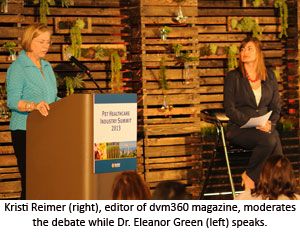Solving the Latino problem in veterinary medicine
Latinos visit the veterinarian less than other Americans, according to some attendees at the 2013 Banfield Pet Healthcare Industry Summit. But at least one study says different.
It was a debate for the ages, more riveting than Barack Obama vs. Mitt Romney, more compelling than Ronald Reagan vs. Jimmy Carter. That's right—it was veterinarian vs. veterinarian.
Dr. Eleanor Green, dean of the Texas A&M College of Veterinary Medicine and Biological Science, suggested there are still plenty of jobs in veterinary medicine. Dr. Mike Thomas, founder of Noah Animal Hospitals and past president of the Companion Animal Parasite Council and the American Animal Hospital Association, took the opposite view suggesting the profession is saturated, noting the high student debt and difficulty in finding quality jobs. The two duked it out at the 2013 Banfield Pet Healthcare Industry Summit Aug. 13 in Portland, Ore. Kristi Reimer, editor of dvm360 magazine, moderated the debate.

The big issue seemed to be why veterinarians practicing today aren't busy enough. And one angle discussed was changing demographics, a growing U.S. Latino community, and the fact that Latinos may visit the veterinarian less often than white pet owners. The two bantered on stage as to why that might be.
But when I talked to Dr. Carlos Campos, recent recipient of the American Veterinary Medical Foundation award for America's Favorite Veterinarian, he had a different view of the Latino community. Dr. Campos, as a native of Guatemala, told me, "When I opened the hospital and announced that I was bilingual, some people were actually so happy they cried, saying they can finally communicate what their dog has. It's wonderful to serve a large subset of the community. I do believe there need to be more bilingual veterinarians."
Campos added, "I don't know why, but obviously there's a lack of diversity in veterinary medicine. Of course, members of the [Latino] community care about their pets."
It turns out that Campos is correct. There is no significant difference in how Latino and non-Latino white owners view their pets, according to one notable study, “Comparison of Strength of the Human-Animal Bond Between Hispanic and Non-Hispanic Owners of Pet Dogs and Cats," (R. Schoefeld, PhD; L. Kogan, PhD; M.L. Wright, DVM; Journal of the American Veterinary Medical Association, Vol. 235, No.5, March, 2000).
While dogs in Latino households may spend more time outdoors, they are absolutely considered family members, according to the study. Those who think Latino pet owners think less of their pets should think again. The proportion of Latino owners with intact pets (particularly males) may be significantly higher than other demographic groups and the percentage that allows cats outdoors may also be higher, but this is a matter of culture not a result of a lack of caring.
I believe it's an unfortunate prejudice that Latino pet owners don't want pets or don't love them as much as anyone's "best clients." Latinos are some veterinarians' very best clients.
I don't have all the answers in the discussion about oversupply of veterinarians, but it's clear that veterinary schools would benefit the profession by finding a way to attract more Latino students, and for that matter, increase diversity across the board. Also, at a community level, shelters and veterinarian organizations should reach out—in Spanish and English—to Latino communities with more education. Most pet owners want to do what's right, Latino pet owners included.